2018 GreenBuilt Tour Offered Opportunity for Many to See Possibilities for Their Home Gardens
The Big Idea for this design was, let's keep all the storm water on the property and save the city system from having to handle any of the client's off-flow. One challenge was remaining financially responsible with some of the construction choices like putting in a concrete driveway instead of permeable pavers, there were considerable savings for the client. But then, we were creating 672 gallons of water in a 2" rain event from the surface area of the driveway that would have gone to the public system. The simple solution: a channel drain to move the water into a swale to move, capture and infiltrate the water. The solution worked like a dream! (See photo below) And in October 2018 the project was officially granted LEED Platinum status. The landscape assisted with 15 points which helped tip the project from Gold to Platinum!
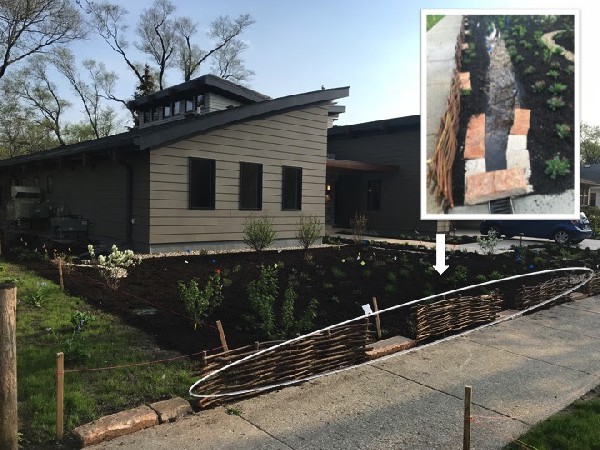
Every year since 2014, Spirited Gardener has had gardens designed and project managed by us on the the Green Built Home Tour which every year has been organized by Illinois Green Alliance (formerly known as USCGB's Illinois Chapter). But we feel this year's landscape is very special. The Pearl Platinum LEED (Leadership in Energy and Environmental Design) project stretched the goals for residential design in the city of Evanston. We worked closely with the owner of the property, Dana Pearl and Nate Kipnis of Kipnis Architecture + Planning.
By focusing on the landscape, the project's LEED certification tipped from Gold to Platinum!LEED Goals met:
- Keep ALL the Rain Water on the Property
- Use High Efficiency Drip Irrigation
- Plant Drought Tolerant Plants to
- Reduce Turf Grass to less than 20%
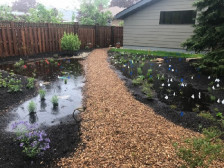
The 2 Rain Gardens pictured here manage water from 2 different roof run-off areas. Within the photo (left) is a 404 sf garden to manage an 800 sf roof area and the Rain Garden to the right manages 919 gallons of run-off in a 2" rain event from the central roof.
The most challenging area was managing the water from the northwest corner of the house where another 800 sf roof area emptied into a very tight spot. To manage the water off of the northwest roof area, we installed 2 Cultec water Rechargers which together accept up to 964 Gallons of water in a 2" rain event and then infiltrates that water into the sandy/rocky base soil of the property. The maximum amount of water would be 1104 gallons but to date, with heavy rain events, there has been no overflow coming out of the system. The Rain Garden above the Rechargers has not yet had to manage any water pushed to the surface from heavy rains and it is ready to manage some overage if necessary. 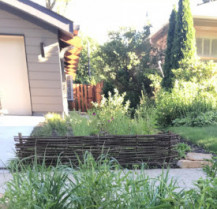
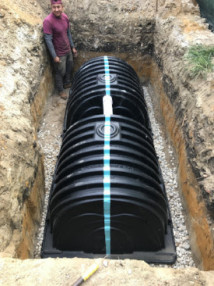
Northwest Corner Rain Garden
View of the Cultec Rechargers
prior to burying them
Getting to know the plants on site will be a vital aspect of Dana's more naturalized landscape. She'll actually have a guide for how to maintain the plants specifically. Keeping the gardens weed free while they grow to maturity will create a much healthier plant community and greater enjoyment for neighbors. By year three, hopefully the need for weeding will be greatly reduced by the mature plants that will shade out any unwelcome visitors. A mistake often made by beginning native plant gardeners is the belief that wild takes care of itself. But being a steward of the land around us is essential for these gardens to succeed and be accepted as a part of the new aesthetic by our neighbors. And educating ourselves and sharing our knowledge with others is essential. As the plants begin to settle in to the gardens, the client gets to know them better.

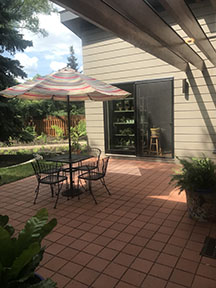 Dana (pictured right) enjoying her first taste
Dana (pictured right) enjoying her first taste of the delicious berries from
her Amelanchier 'Regent' Serviceberry
a shrub form of the popular native tree.
The patio for Dana's back area (pictured left) was set as permeable pavers to allow water to be captured under the patio in a 14" gravel base. The entrance porcelain tile was set the same way. An advantage of setting pavers with permeable spacing is that it is less necessary during freeze thaw cycles to use salt because the water doesn't sit on the surface but has a void space to move in to.
And Dana's criteria for the project were often more ambitious than some of the LEED demands. We sought to recycle and reuse elements if we could, like the green plastic fence section that became a backdrop to a native Honeysuckle vine (pictured below).
The fence material was the more regionally sourced white cedar that comes from Michigan (within the 500 mile radius range) that is considered a better carbon foot print rather than using the Red Cedar that is shipped in from out west.
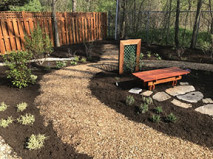
The main thing to remember from the example of the LEED Platinum goals is to inspire us all to seek to do more to improve our relationship with this wonderful place we call home. Stewarding each of our little pieces of the Earth improves the world for all of us.




